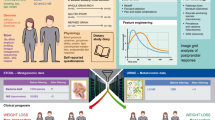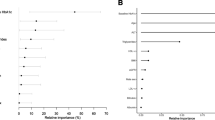Abstract
Estimating the individualized treatment effect has become one of the most popular topics in statistics and machine learning communities in recent years. Most existing methods focus on modeling the heterogeneous treatment effects for univariate outcomes. However, many biomedical studies are interested in studying multiple highly correlated endpoints at the same time. We propose a random forest model that simultaneously estimates individualized treatment effects of multivariate outcomes. We consider a popular study design where covariates and outcomes are measured both before and after the intervention. The proposed model uses oblique splitting rules to partition population space to the neighborhood that experiences distinct treatment effects. An extensive simulation study suggests that the proposed method outperforms existing methods in various nonlinear settings. We further apply the proposed method to two nutrition studies investigating the effects of food consumption on gastrointestinal microbiota composition and clinical biomarkers. The method has been implemented in a freely available R package MOTE.RF at https://github.com/boyiguo1/MOTE.RF.



Similar content being viewed by others
Code Availability
The method has been implemented in a freely available R package MOTE.RF at https://github.com/boyiguo1/MOTE.RF.
References
Athey S, Imbens G (2016) Recursive partitioning for heterogeneous causal effects. Proc Natl Acad Sci 113(27):7353–7360
Athey S, Tibshirani J, Wager S (2019) Generalized random forests. Ann Stat 47(2):1148–1178
Ball MP, Bobe JR, Chou MF, Clegg T, Estep PW, Lunshof JE, Vandewege W, Zaranek AW, Church GM (2014) Harvard personal genome project: lessons from participatory public research. Genome Med 6(2):10
Breiman L (2001a) Random forests. Machine Learn 45(1):5–32
Breiman L (2001b) Statistical modeling: the two cultures. Stat Sci 16(3):199–231
Brinkley J, Tsiatis A, Anstrom KJ (2010) A generalized estimator of the attributable benefit of an optimal treatment regime. Biometrics 66(2):512–522. https://doi.org/10.1111/j.1541-0420.2009.01282.x
Cai T, Tian L, Wong PH, Wei LJ (2011) Analysis of randomized comparative clinical trial data for personalized treatment selections. Biostatistics (Oxford, England) 12(2):270–82. https://doi.org/10.1093/biostatistics/kxq060
Callahan BJ, Sankaran K, Fukuyama JA, McMurdie PJ, Holmes SP (2016) Bioconductor workflow for microbiome data analysis: from raw reads to community analyses. F1000Research 5
Chen J, Bushman FD, Lewis JD, Wu GD, Li H (2013) Structure-constrained sparse canonical correlation analysis with an application to microbiome data analysis. Biostatistics 14(2):244–258
Collins FS, Varmus H (2015) A new initiative on precision medicine. N Engl J Med 372(9):793–795. https://doi.org/10.1056/NEJMp1500523
Cook RD, Li B, Chiaromonte F (2010) Envelope models for parsimonious and efficient multivariate linear regression. Stat Sin pp 927–960
Davies A, Ghahramani Z (2014) The random forest kernel and creating other kernels for big data from random partitions. arXiv:14024293
Egozcue JJ, Pawlowsky-Glahn V, Mateu-Figueras G, Barcelo-Vidal C (2003) Isometric logratio transformations for compositional data analysis. Math Geol 35(3):279–300
Foster JC, Taylor JMG, Ruberg SJ (2011) Subgroup identification from randomized clinical trial data. Stat Med 30(24):2867–2880. https://doi.org/10.1002/sim.4322
Geurts P, Ernst D, Wehenkel L (2006) Extremely randomized trees. Machine Learn 63(1):3–42
Gordon L, Olshen RA (1985) Tree-structured survival analysis. Cancer Treat Rep 69(10):1065–1069
Holscher HD, Taylor AM, Swanson KS, Novotny JA, Baer DJ (2018) Almond consumption and processing affects the composition of the gastrointestinal microbiota of healthy adult men and women: A randomized controlled trial. Nutrients 10(2):126
Hotelling H (1936) Relations between two sets of variables. Biometrika 28(3–4):321–377
Hothorn T, Bühlmann P, Dudoit S, Molinaro A, Van Der Laan MJ (2005) Survival ensembles. Biostatistics 7(3):355–373
Ishwaran H, Kogalur UB, Blackstone EH, Lauer MS (2008) Random survival forests. Ann Appl Stat pp 841–860
Kosorok MR, Moodie EE (2015) Adaptive treatment strategies in practice: planning trials and analyzing data for personalized medicine, vol 21. SIAM
Laber EB, Zhao YQ (2015) Tree-based methods for individualized treatment regimes. Biometrika 102(3):501–514. https://doi.org/10.1093/biomet/asv028
LeBlanc M, Crowley J (1992) Relative risk trees for censored survival data. Biometrics 411–425
Li KC (1991) Sliced inverse regression for dimension reduction. J Am Stat Assoc 86(414):316–327
Li H (2019) Statistical and computational methods in microbiome and metagenomics. Handbook Stat Genomics 977–550
Liaw A, Wiener M (2002) Classification and regression by randomforest. R News 2(3):18–22
Lipkovich I, Dmitrienko A, Denne J, Enas G (2011) Subgroup identification based on differential effect search—a recursive partitioning method for establishing response to treatment in patient subpopulations. Stat Med 30(21):2601–2621. https://doi.org/10.1002/sim.4289
Loh WY, He X, Man M (2015) A regression tree approach to identifying subgroups with differential treatment effects. Stat Med 34(11):1818–1833.
Meinshausen N (2006) Quantile regression forests. J Mach Learn Res 7(Jun):983–999
Meng C, Zeleznik OA, Thallinger GG, Kuster B, Gholami AM, Culhane AC (2016) Dimension reduction techniques for the integrative analysis of multi-omics data. Brief Bioinform 17(4):628–641
Menze BH, Kelm BM, Splitthoff DN, Koethe U, Hamprecht FA (2011) On oblique random forests. In: Joint European conference on machine learning and knowledge discovery in databases, Springer, Berlin, pp 453–469
Nadeem N, Woodside JV, Neville CE, McCall DO, McCance D, Edgar D, Young IS, McEneny J (2014) Serum amyloid a-related inflammation is lowered by increased fruit and vegetable intake, while high-sensitive c-reactive protein, il-6 and e-selectin remain unresponsive. Br J Nutr 112(7):1129–1136
Ozato N, Saito S, Yamaguchi T, Katashima M, Tokuda I, Sawada K, Katsuragi Y, Kakuta M, Imoto S, Ihara K, et al. (2019) Blautia genus associated with visceral fat accumulation in adults 20–76 years of age. NPJ Biofilms Microbiomes 5(1):1–9
Peplow M (2016) The 100 000 genomes project. BMJ 353. https://doi.org/10.1136/bmj.i1757
Peterson CB, Stingo FC, Vannucci M (2016) Joint bayesian variable and graph selection for regression models with network-structured predictors. Stat Med 35(7):1017–1031
Qian M, Murphy SA (2011) Performance guarantees for individualized treatment rules. Ann Stat 39(2):1180
R Core Team (2020) R: A Language and Environment for Statistical Computing. R Foundation for Statistical Computing, Vienna, Austria. https://www.R-project.org/
Rainforth T, Wood F (2015) Canonical correlation forests. ArXiv e-prints
Rohart F, Gautier B, Singh A, Lê Cao KA (2017) mixomics: an R package for ’omics feature selection and multiple data integration. PLoS Comput Biol 13(11):e1005752
Rubin DB (1974) Estimating causal effects of treatments in randomized and nonrandomized studies. J Educ Psychol 66(5):688
Ryan KK, Tremaroli V, Clemmensen C, Kovatcheva-Datchary P, Myronovych A, Karns R, Wilson-Pérez HE, Sandoval DA, Kohli R, Bäckhed F et al (2014) FXR is a molecular target for the effects of vertical sleeve gastrectomy. Nature 509(7499):183–188
Sega M, Xiao Y (2011) Multivariate random forests. Wiley Interdiscip Rev 1(1):80–87. https://doi.org/10.1002/widm.12
Simon N, Friedman J, Hastie T, Tibshirani R (2011) Regularization paths for cox’s proportional hazards model via coordinate descent. J Stat Softw 39(5):1–13
Su X, Tsai CL, Wang H, Nickerson DM, Li B (2009) Subgroup analysis via recursive partitioning. J Mach Learn Res 10:141–158
Tenenhaus A, Tenenhaus M (2011) Regularized generalized canonical correlation analysis. Psychometrika 76(2):257
Tenenhaus M, Tenenhaus A, Groenen PJ (2017) Regularized generalized canonical correlation analysis: a framework for sequential multiblock component methods. Psychometrika 82(3):737–777
Thompson S, Bailey M, Taylor A, Kaczmarek J, Krug A, Edwards C, Reeser G, Burd N, Khan N, Holscher H (2020) Avocado consumption alters gastrointestinal bacteria abundance and microbial metabolite concentrations among adults with overweight or obesity: a randomized, controlled trial. J Nutr (accepted)
Tian L, Alizadeh AA, Gentles AJ, Tibshirani R (2014) A simple method for estimating interactions between a treatment and a large number of covariates. J Am Stat Assoc 109(508):1517–1532
Wold S, Sjöström M, Eriksson L (2001) Pls-regression: a basic tool of chemometrics. Chemom Intell Lab Syst 58(2):109–130
Ze X, Duncan SH, Louis P, Flint HJ (2012) Ruminococcus bromii is a keystone species for the degradation of resistant starch in the human colon. ISME J 6(8):1535–1543
Zhang B, Tsiatis AA, Davidian M, Zhang M, Laber E (2012a) Estimating optimal treatment regimes from a classification perspective. Stat 1(1):103–114. https://doi.org/10.1002/sta.411
Zhang B, Tsiatis AA, Laber EB, Davidian M (2012b) A robust method for estimating optimal treatment regimes. Biometrics 68(4):1010–1018
Zhang B, Tsiatis AA, Laber EB, Davidian M (2013) Robust estimation of optimal dynamic treatment regimes for sequential treatment decisions. Biometrika 100(3):681–694. https://doi.org/10.1093/biomet/ast014
Zhang Y, Laber EB, Tsiatis A, Davidian M (2015) Using decision lists to construct interpretable and parsimonious treatment regimes. Biometrics 71(4):895–904. https://doi.org/10.1111/biom.12354
Zhao Y, Zeng D, Rush AJ, Kosorok MR (2012) Estimating individualized treatment rules using outcome weighted learning. J Am Stat Assoc 107(499):1106–1118. https://doi.org/10.1080/01621459.2012.695674
Zhao L, Tian L, Cai T, Claggett B, Wei LJ (2013) Effectively selecting a target population for a future comparative study. J Am Stat Assoc 108(502):527–539. https://doi.org/10.1080/01621459.2013.770705
Zhu R, Kosorok MR (2012) Recursively imputed survival trees. J Am Stat Assoc 107(497):331–340
Zhu X, Qu A (2016) Individualizing drug dosage with longitudinal data. Stat Med 35(24):4474–4488
Zhu R, Zhao YQ, Chen G, Ma S, Zhao H (2017) Greedy outcome weighted tree learning of optimal personalized treatment rules. Biometrics 73(2):391–400. https://doi.org/10.1111/biom.12593
Author information
Authors and Affiliations
Corresponding author
Rights and permissions
About this article
Cite this article
Guo, B., Holscher, H.D., Auvil, L.S. et al. Estimating Heterogeneous Treatment Effect on Multivariate Responses Using Random Forests. Stat Biosci 15, 545–561 (2023). https://doi.org/10.1007/s12561-021-09310-w
Received:
Revised:
Accepted:
Published:
Issue Date:
DOI: https://doi.org/10.1007/s12561-021-09310-w




